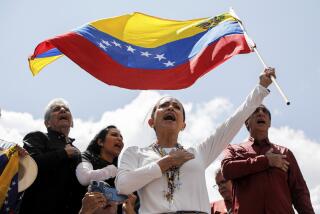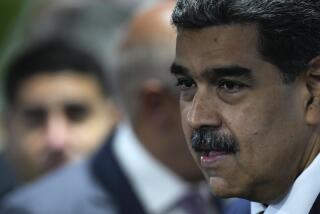Insider : If Castro Stumbles, Will U.S. Give Him a Shove? : Washington seems to want to maintain a hands-off policy. Strategic planners now say that with no Cold War, Cuba is just another island in the stream.
- Share via
WASHINGTON — The place is Cuba. The time: December, 1991.
Food shortages have led to riots. Some Cuban forces refuse to fire on crowds, and civil war erupts. Army troops shoot at refugees pouring into the American enclave at Guantanamo Bay, hitting a U.S. Marine. The lone Soviet brigade in Cuba rings its huge electronic eavesdropping antenna at Lourdes, signaling Moscow’s intent to stay out of the conflict.
What should the United States do?
Nothing, according to senior policy strategists who examined the situation at a Harvard University national security seminar this past summer. Retired Marine Lt. Gen. Bernard Trainor, the seminar’s director, summed up the consensus tersely: “Let them shoot it out among themselves.”
The reason is that Cuba has become irrelevant to U.S. national security concerns. Once, Pentagon strategists worried that submarines and bombers based there might intercept U.S. transports carrying troop reinforcements to Europe in case of a conflict with the Soviet Union.
With the end of the Cold War, however, Cuba has become just another island in the stream. And with economic and ideological strains now forcing the Soviet Union to slash its $5-billion-a-year subsidy to Cuba, Fidel Castro is on a rapidly sinking ship of state.
The Bush Administration would like to follow just such a hands-off policy. But Cuban exiles in the United States, while somewhat weaker than they were a decade ago, remain a significant political force, particularly in the Republican Party.
As a result, the United States may not be able to stay out of any Cuban conflict--whether it is one set off by food riots, the defection of young Communist dissidents or some other spark--in the face of boatloads of drowning refugees or a wholesale slaughter of opponents by Castro.
Critics on both sides want U.S. policy to change. Conservatives want to speed Castro’s fall by squeezing the island further economically. Others outside the government are urging the Administration to “reach out” to Cubans, easing some sanctions in hopes of influencing Castro’s successors to be less hostile.
Administration policy today is squarely in the middle: Policy makers are watching Cuban developments daily but remaining aloof, yet ready to act. President Bush has allowed the controversial TV Marti propaganda broadcasts--begun by the Reagan Administration--to go forward. And he continues to urge Moscow to cut back on support for Castro.
But the White House opposes proposals to cut off remittances by Cuban exiles to families on the island or to close loopholes in the 28-year-old U.S. economic embargo against Castro. “To torque up the pressure might allow Castro to shift the blame for the coming chaos to us,” a senior State Department official says, while “to ease up--allowing more travel to Cuba by exiles in Florida and official interchanges--might increase the reform pressure on him.”
“But it takes two to tango,” the official warns. “Castro has clamps on entry visas. Besides, although he has brought Cuban troops home from Africa on schedule, he’s still heavily supporting the FLMN (rebels) in El Salvador. So we’re staying where we are, letting the changes in the (Communist) world take their course. We can’t influence events in Cuba all that much anyway. So--no new initiatives now.”
U.S. officials are convinced that Castro will not allow any democratic or free-market reforms in Cuba and that he will not step down peacefully. “Socialism or death!” he defiantly vows as he imposes ever more severe austerity measures on his people and tightens even further his control of political life and discourse.
Now 63, Castro warned Cubans this month that this is “the most difficult moment we have known” since the 1959 revolution--more threatening than the U.S.-backed Bay of Pigs invasion, which he crushed, and more bitter than the Cuban missile crisis, when the Soviets withdrew their nuclear missiles without his permission rather than run a U.S. naval blockade.
To some analysts, however, the irony is that Castro is being brought down more by Moscow’s failures rather than by the hated Yanquis of the United States.
“No one is able to assure us under what conditions we will receive (Soviet) oil in the future, what the prices our products (exports) will be, and at what price they will sell us their products,” he complained earlier this month.
Even before last winter’s democratic upheavals in Eastern Europe and wrenching perestroika reforms in the Soviet Union, there were signs that “the Cuban revolution and its leader had begun to lose their moral authority,” Susan Kaufman Purcell wrote last summer in the Foreign Affairs quarterly.
Havana’s government appeared increasingly corrupt and heavily involved in drug-trafficking. And Castro staged a still-unexplained show trial and execution of Arnaldo Ochoa Sanchez, a popular general and Angola war hero. The Sandinista government in Nicaragua, which he supported with arms and advice, lost at the ballot box.
But it has been the economic body-blows to Cuba from the collapse of the Communist world that have been the most devastating.
Over 70% of Cuba’s trade is with Moscow and another 15% is with East Europe--most of it heavily subsidized. Radical changes are occurring, despite the promise of continued support from the top Soviet leadership.
The new East European governments are totally unsympathetic to Cuba, and while the Soviet Union may be more willing to help, it has been constrained by the collapse of its own economy. Last year, for example, Soviet oil production dropped about 10%, and Soviet rail and ship transportation have been interrupted periodically. So crucial petroleum deliveries--the source of all of Cuba’s energy--have already fallen seriously short, perhaps as much as 15% to 20%.
The future, if anything, looks even more bleak.
Soviet President Mikhail S. Gorbachev promised that the new five-year Soviet-Cuban trade agreement being prepared this year would provide for an 8% increase in two-way barter. But the Soviet public increasingly demands severe cuts in foreign aid, and Gorbachev’s new economic plan calls for a 75% cut.
Ramon Gonzalez Vergara, a former senior Cuban official who took part in the trade negotiations with Moscow, said earlier this month that the Soviets intend to reduce support drastically in almost every area. Unless Castro introduces radical policy changes, Cuba’s economy will be crippled within a year and a half, Gonzalez Vergara, who defected in July, told a University of Miami meeting.
Castro’s response to the crisis was not reform but merely demands for greater sacrifice by Cubans. He had already instituted a “special period in time of peace,” cutting bus service by 30% and home electricity consumption by 10%, canceling construction of schools and other public facilities, and threatening even more Draconian austerity measures.
He also had tightened control on the populace by installing army commanders in many top political and police posts--including neighborhood surveillance agencies--with orders to “accentuate revolutionary vigilance” so as to “avoid antisocial actions.” According to Castro biographer Tad Szulc, that means intensified spying on Cubans.
But Castro’s government will probably not crumble as easily as those of the former East European satellites. His revolution was home-grown, not imposed by Soviet tanks. Even critical U.S. officials believe that he would win at least one-third of any popular vote today.
And Moscow may not be as willing to let Cuba collapse because it gets at least some return for its subsidies, allowing it to buy Cuban sugar and citrus at above-market prices in exchange for its oil.
In particular, the Soviet electronic spy facility at Lourdes--the largest of its kind outside the Soviet Union--provides invaluable information, not only about U.S. military activities but also about international economic and financial transactions, which are of increasing value to Moscow.
Soviet military aid to Cuba, about $1.2 billion a year, has not decreased--indeed, a squadron of sophisticated MIG-29s arrived recently--suggesting that the Red Army, at least, continues to value Cuba highly.
Castro also has some leverage of his own. When the drop in Soviet oil deliveries required cutbacks in electricity consumption, for example, he closed one of the giant Cuban nickel refineries that provide the Soviet Union with the metal. Similarly, Moscow’s subsidies are all in “soft” currencies. If the Soviets went on the world market for sugar, they would be forced to pay in dollars, which are in short supply in Moscow as well.
Nonetheless, the prognosis for Castro is bad and growing worse.
Some U.S. officials believe that the December, 1991, timetable for the so-far-theoretical Cuban upheaval is too early, while others are betting that Castro will be out before the end of this year. Like those at the Harvard seminar, Gillian Gunn, the Carnegie Endowment’s Cuban expert, believes the crunch will come in about a year.
Gunn predicts that “in late 1991, Cuba will be an accordion getting squashed” between shrinking Soviet aid and the internal dissent erupting at the Cuban Communist Party Congress that is scheduled for March or April. “I still don’t think collapse is a probability, but it’s a growing possibility as the Soviet deterioration accelerates,” she says.
More to Read
Sign up for Essential California
The most important California stories and recommendations in your inbox every morning.
You may occasionally receive promotional content from the Los Angeles Times.










